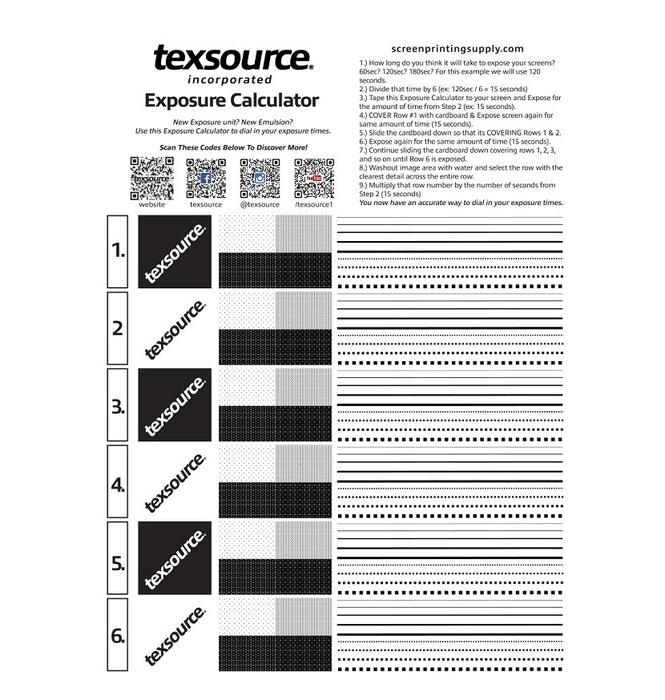
Exposure Calculator for Screen Printers

An invaluable tool for proper screen exposure, this highly detailed film print will prove to be an excellent addition to your shop as an aid in determining proper screen exposure times. Printed on high quality film and ready to use!
Here are some of the issues you may encounter when your screen exposure time is too low -
- The screen could be difficult to reclaim when it is under exposed, since the under exposed emulsion can react with the screen reclaiming chemicals.
- The printed image could have poor edge definition.
- The stencil could break down during a print run.
- The stencil could break down during washout of the screen.
- The screen could suffer from pinholes.
While some of these issues may also be caused by other factors, incorrect screen exposure time is of great importance. By comparison, the main problem associated with over-exposure is that the screen may not wash out properly and fine detail will be lost.
How To Determine Correct Exposure Time
While manufacturers do provide guideline exposure times, it is rare that their guidelines are for the exact make and model of your screen exposure unit, or indeed for a suitably coated screen with high emulsion over mesh (EOM), which means that trial and error is the order of the day. It is therefore important that you have a procedure in place to test all your emulsions to ensure correct screen exposure time is used at all times.
Follow these steps for proper use of this calculator
- How long do you think it will take to expose your screens? 60sec? 120sec? 180sec? You can often refer to manufacturer recommendations for estimated times. For this example we will use 120 seconds.
- Divide that time by 6 (ex: 120sec / 6 = 20 seconds)
- Tape this Exposure Calculator to your screen and Expose for the amount of time from Step 2 (ex: 20 seconds).
- COVER Row #1 with cardboard & Expose screen again for same amount of time (20 seconds).
- Slide the cardboard down so that its COVERING Rows 1 & 2.
- Expose again for the same amount of time (20 seconds).
- Continue sliding the cardboard down covering rows 1, 2, 3, and so on until Row 6 is exposed.
- Washout image area with water and select the row with the clearest detail across the entire row.
- Multiply that row number by the number of seconds from Step 2 (20 seconds)
You now have an accurate way to dial in your exposure times.

